Content
- 1 Choosing the right seeds
- 2 Germination
- 3 Substrate preparation
- 4 Planting seeds
- 5 Natural selection
- 6 Picking
- 7 Irrigation water and sunlight
- 8 Other nuances
- 9 Video: how to grow pomegranate
- 10 Planting seeds (seeds) of pomegranate
- 11 Caring for a pomegranate at home
- 12 Top dressing
- 13 Pruning home pomegranate
- 14 Transfer
- 15 Possible problems: diseases and pests
- 16 The process of growing pomegranate from seed
- 17 Growing
Pomegranate fruit is a symbol of friendship and fertility. Hindus recommend red seeds to rejuvenate the body, and the peel to cleanse from parasites. Pink pomegranate flowers will decorate any windowsill and fill the house with harmony and love. So why not grow your own miniature bone tree?

Choosing the right seeds
Where can I get planting material? Buy a large fruit of a rich shade on the market or in a store. Do not take rotten or moldy fruits for planting. The seeds obtained from such specimens are weak and painful, do not germinate and develop well.
Only healthy ripe pomegranates are suitable, which must be carefully cut and removed. Remove the soft shell, and put the seeds in a colander and rinse under the tap to remove juice and pieces of pulp. Examine the bones carefully. Only hard, grayish-beige or ivory-colored seeds will do. This means they are ripe and have enough nutrients to germinate. The planting material is green, soft to the touch, does not germinate. Such bones simply rot, falling into the ground, and disappear.
how to grow lemon at home
Germination
Put the pomegranate seeds on a saucer and pour a little water so that they are half immersed in the liquid. The planting material needs air, because oxygen awakens the seed and starts the germination process. The bones cannot float in the water, otherwise they will die.
The planting material must be disinfected. Means such as "Zircon" or "Epin" are recommended. Only 2-3 drops, and no fungus and rot. Change the solution in a saucer every 12 hours. The seeds should lie in water for about 3 days, and it is impossible for them to dry out, otherwise the hard shell will crack and the grain will die.
You can cover the saucer with gauze or cotton cloth, which retains moisture well. Water intended for soaking should be passed through a filter to remove harmful impurities. Put the saucer in a warm place, away from drafts.
The bones after three days of bathing practically do not change their appearance. Unlike other planting material, they do not germinate in a plate, but already in the ground. It is important to prepare the correct soil and pots in advance, because the grains are put into the soil directly from the plate.
Substrate preparation
Pomegranate takes root in almost any land, but for the plant to be strong and develop quickly, one of three options should be used. The easiest way is to buy a special substrate designed for indoor flowers. It contains many nutrients, is quite loose and breathable.
The second version of the soil is prepared from peat and coarse river sand, which is pre-calcined or doused with boiling water in order to disinfect. Take the components in equal proportions, mix thoroughly and fill the pot with the mixture.
If peat is not at hand, it is replaced with turf soil and humus. Combine the ingredients and insist for several days, and add river sand before planting the pomegranate seeds.The last component will make the soil looser and softer, and humus will become a source of minerals.
Regardless of the composition of the substrate, you need to put a drainage layer in the pot. If it is absent, water constantly stagnates at the bottom of the container, the roots of the tree rot, and it suffers from a fungus. Expanded clay or small pebbles, pieces of foam or crushed clay shards are suitable.
Tip: If the soil dries out quickly or compresses too much, it should be replaced with new soil, to which pine or other sawdust is added.
how to grow bonsai correctly
Planting seeds
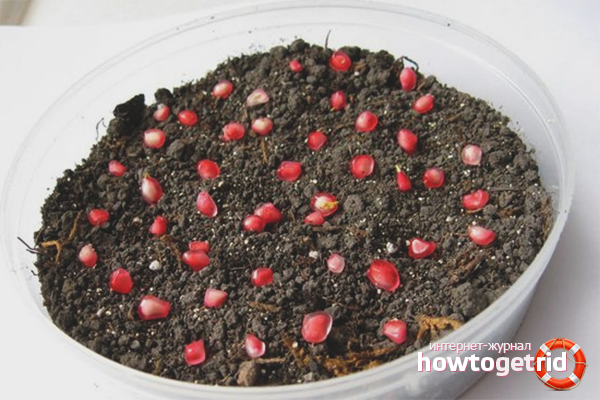
- Fill the pot with substrate, make several holes 1–1.5 cm deep in it and moisten slightly with a spray bottle.
- Do not make the pits too deep, otherwise it will be difficult for the sprout to break through the ground.
- Put a wet seed and sprinkle with soil, without tamping it.
- Sprinkle with water and cover the pot with cling film or plastic bag. You will get a mini-greenhouse, in which it is always warm and humid.
- There is no need to add fertilizers or growth promoters. Pomegranate seeds will take essential nutrients from the soil.
- The main thing is that the pot with the future tree is constantly warm.
It is recommended to plant seeds in winter so that the first shoots appear by spring, so the pomegranate can be kept next to the battery, but make sure that the earth does not dry out.
Natural selection
When the shoots hatch, it is recommended to rearrange the pot on the south window. Young trees need a lot of light to grow and gain strength. Do not remove the film, but regularly ventilate the sprouts, slightly opening the improvised lid for 1-2 hours, and water. The soil must not be too wet or water accumulates at the bottom. In such cases, you need to stop watering for several days so that the substrate dries up, and further reduce the amount of liquid to moisten the soil.
If the seeds are planted in winter, the first leaves will appear on the shoots in early to mid-spring. Then the film is removed so that it does not interfere with the trees being pulled up. Only one plant is left in the pot, the strongest and largest. The rest must be carefully pulled out. You can simply pinch off the top, leaving the spine in the ground. It will gradually decompose, supplying the developing sprout with additional nutrients.
Important: Not all seeds planted in winter hatch in March-April. Some may take months to wake up, so empty pots without shoots are recommended not to be thrown away, but set aside and continue to water. If after 6 months nothing has happened, then the seeds have not sprouted.
how to grow a money tree at home
Picking
The seedlings may not be thinned out, but transplanted into separate containers. A pomegranate pick is carried out after the appearance of two real, not cotyledonous, leaves.
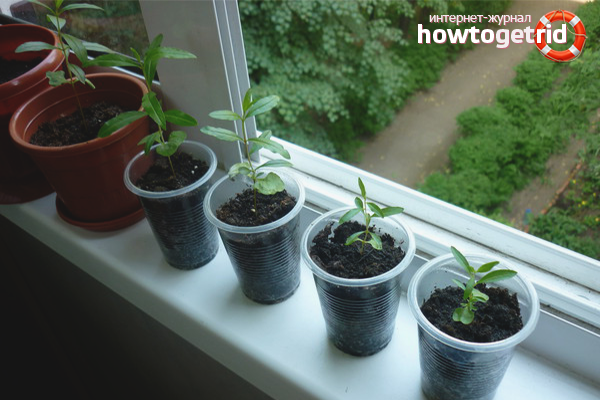
How to carry out the procedure?
- It will take several medium-sized pots. The amount depends on how many trees you plan to grow.
- Fill each pot with drainage and pine sawdust substrate.
- Make one hole 2–2.5 cm deep. Be sure to moisten the ground so that the pomegranate takes root quickly.
- Gently spread the roots over the fossa. Sprinkle the seedling with earth, tamp the soil a little.
- You can add water, but if the substrate is moist enough, watering should be postponed for several days.
Too thin and weak or crooked seedlings are recommended to be thrown away. Painful trees grow from them, which are constantly attacked by pests or fungi.
how to grow a peach from a stone
Irrigation water and sunlight
Pomegranate comes from warm countries, so the tree adores the sun and tolerates high temperatures normally. The pot with the plant can be placed on the southern windowsill, closer to the light, but be sure to shade the delicate leaves from ultraviolet radiation.It is advisable to hang patterned curtains or blinds on the windows, which scatter the sun's rays and make them softer.
In summer, it is useful to take the pomegranate tree out to the balcony. The owners of summer cottages move the pot with the plant to the garden. In the open air, the pomegranate blooms faster and develops better. It is recommended to bury the pot with earth, hiding the seedling under a taller tree.
In winter, water pomegranates 2 times a week, and in summer up to 4–5. If the ground inside remains damp and the top layer dries quickly, it should be sprayed with a spray bottle. Water should not come into contact with tree leaves and flowers. Use only warm, settled liquid, into which fertilizers for indoor flowers or complexes for tomatoes and sweet peppers can be added in spring and summer. Among natural feeds, manure infusion and aquarium water are distinguished. You need to fertilize the soil twice a month, before adding nutrients, pomegranates are watered abundantly.
Other nuances
- To make the tree fluffy, you need to pinch the fourth after the appearance of the third pair of leaves. This will cause the pomegranate to grow on two tops.
- The plant will bear fruit if grafted. In other cases, a tree grown from a stone only blooms, but no fruit appears on it.
- Closer to winter, around November or early December, the pomegranate sheds its leaves. When the last one falls, you need to take the pot to a cool greenhouse or cellar. The plant should overwinter at a temperature of + 5–0 degrees.
- From November to March, pomegranates are watered every 1.5–2 months. You don't need to fertilize.
During the flowering period, you can try to pollinate the plant with a brush or cotton swab. No one guarantees that an ovary will appear on the pomegranate, but it is likely that by autumn several fruits will ripen on thin branches. Even if the tree will not give birth annually, it is worth planting for the beautiful pink buds that will appear every 10 months.
how to grow pineapple at home
Video: how to grow pomegranate
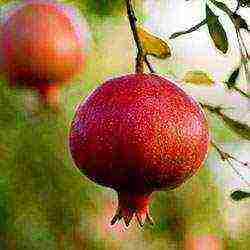 Pomegranate is a genus of small trees and shrubs that have been known throughout the world for more than one century for their incredibly tasty and very healthy fruits. Unfortunately, it is not easy to grow such a tree in the garden, so many amateur gardeners try to grow a plant at home. Today you will learn how to grow a pomegranate from a simple seed in order to get fruits as a result (photos and instructions are attached).
Pomegranate is a genus of small trees and shrubs that have been known throughout the world for more than one century for their incredibly tasty and very healthy fruits. Unfortunately, it is not easy to grow such a tree in the garden, so many amateur gardeners try to grow a plant at home. Today you will learn how to grow a pomegranate from a simple seed in order to get fruits as a result (photos and instructions are attached).
Pomegranate: description, properties of the plant, characteristics of varieties
Indoor or dwarf (as it is also called) pomegranate is a small tree, the height of which rarely exceeds 1 m. The branches of the plant are quite thin and prickly to the touch. Leaves of a light green hue, with a glossy surface, slightly elongated oval, can reach 2-3 cm.
Dwarf pomegranate varieties rarely produce generous yields. Nevertheless, the small number of them, which is tied on the branches, can reach quite impressive sizes for such a tree - pomegranate fruits are about 4-5 cm in diameter.
Oddly enough, but the fruits of the dwarf pomegranate differ in the same spicy taste as the fruits of the ordinary pomegranate. Importantly, these fruits have properties that are incredibly useful for the human body. Therefore, amateur gardeners (and not only) are happy to grow this luxurious plant in an apartment, in warm small greenhouses, gardens and even in small pots.
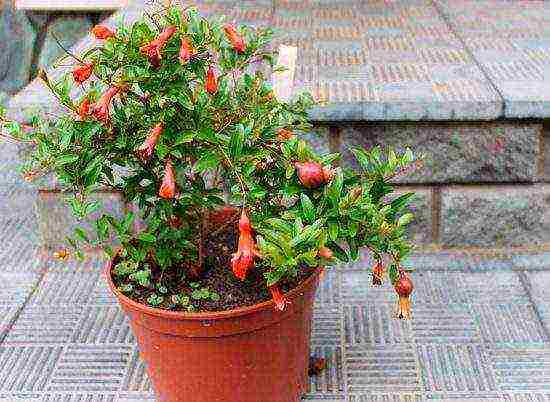
Baby pomegranate
There are about 500 different varieties of pomegranate, among which there are several that are suitable for indoor growing:
- Baby. A half-meter plant, which during the flowering period is covered with single or collected in miniature bunches of flowers, and rather large fruits (about 6 cm) of yellow-brown color with a slight pink blush. Pollination is required.
- Carthage.During the flowering period of the plant, you can observe small, but lushly growing red flowers (from late spring to the first autumn days) and the same small, very tasty juicy fruits.
- Shah-nar. The Azerbaijani version of the dwarf pomegranate, with proper care, pleases with small round / pear-shaped fruits with very tasty juicy seeds.
- Ruby. Reaches 0.5-0.7 m in height. Compared to other varieties, the trees of this variety are distinguished by an unusual color of foliage: the flowers of the tree are painted in a bright ruby color. With proper care, fruits can reach 7-8 cm in diameter.
- Uzbekistan. This domestic variety of pomegranate can be safely called gigantic: it reaches a height of 2 m. Fruits are medium in size (they can reach 100-120 g in weight), spherical in shape, with a thin peel of a bright red color.
Planting culture
The seed is selected seeds from ripe, beautiful and, most importantly, healthy pomegranate. It is also important to ensure that the location is chosen correctly. First, it must be sufficiently sunny: the best option is south, southwest. With sufficiently intense sunlight, it is advisable to clean the plant in a little shade, and in winter keep it in a room with a temperature of about +10 degrees.
Attention! Keep in mind that those pomegranate seeds for sowing, which are sold in specialized stores, are hybrids, so the fruits that will result from growing a plant from a purchased seed will not have the taste of the mother tree, but decorativeness will certainly be at its best.
The best option for obtaining a suitable pomegranate seed is from the ripe fruit of an already growing indoor pomegranate. So, first remove all the grains from the fruit and carefully clean them from the pulp. They should be soft cream in color and firm to the touch.
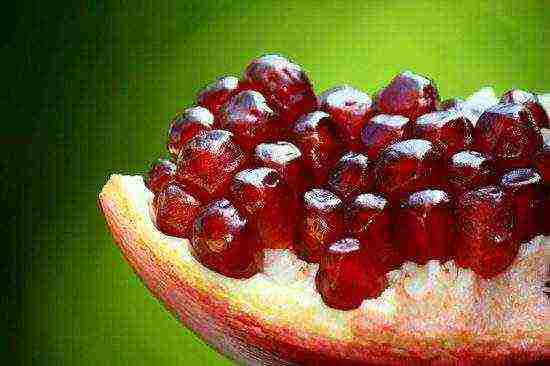
Take seeds from ripe pomegranate fruits
For 10 hours, you can soak the extracted seeds in water, to which a few drops of a growth stimulating solution have been added. Moreover, the water should not completely cover them so that the seeds have access to oxygen.
For sowing pomegranate seeds, a universal soil familiar to flower growers, which is sold in specialized stores, is suitable. It usually consists of fertile soil, peat and sand. The previously prepared pomegranate seeds should be thoroughly dried, then placed in the ground to a depth of about 1.5 cm. Then slightly moisten with water, cover with foil or glass, and put in a warm place. The process of sowing pomegranate seeds is usually carried out in late winter and early spring: in this case, the percentage of germination is much higher, and the first shoots will appear in a few weeks.
Remember to moisturize the soil from time to time and ventilate it every day. When the first three full-fledged leaves appear, you can transplant young seedlings in separate pots. When 5-6 full-fledged leaves are formed on young shoots, they should be pinched so that 2 shoots grow. It is important to pinch a well-grown plant again so that the pomegranate turns into a real tree.
Subtleties of pomegranate care
In order for the pomegranate tree to feel comfortable and be able to fully bloom in its due time, it is important to make sure that it receives all the care it needs.
So let's start with watering. It is necessary to carry out this process clearly at the root, so that moisture does not get on the pomegranate leaves. The substrate must always be slightly damp. During the flowering period, it is desirable to minimize it, but the soil should in no case dry out. It is advisable to use warm, settled water for irrigation. In winter, the amount of moisture should be kept to a minimum.
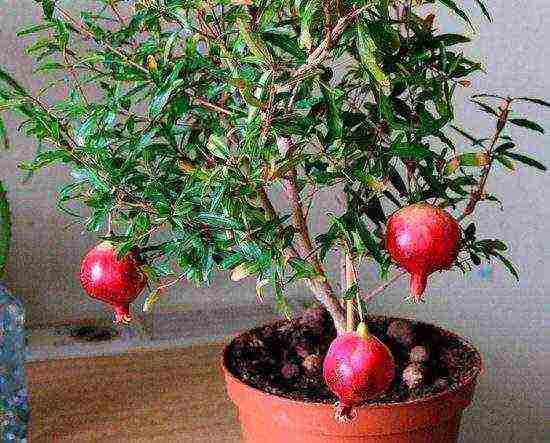
Homemade pomegranate can bear fruit
During the period of active development of seedlings, you can feed young sprouts with wood ash diluted with water in a 1: 1 ratio.During the flowering period, the tree should be fed with liquid complex fertilizers for plants (frequency - 2 times a month with a break of 2 weeks).
Household pomegranate is quite often affected by various pests such as aphids, ticks and moths. From the first, you can protect the plant with a solution consisting of water, tobacco and laundry soap. An onion or garlic infusion will help with all the rest.
Sometimes pomegranate is sick with cancer, which manifests itself in cracking of the bark, drying out of branches and the appearance of spongy swellings on the surface of the bark. When the first signs of the disease are found, the bark should be immediately cleaned to a healthy tissue, treated with copper sulfate and then covered with garden varnish.
In principle, the above activities are enough to grow a full-fledged pomegranate tree at home, which in due time will delight you with delicious fruits. Good luck!
Growing indoor pomegranate: video
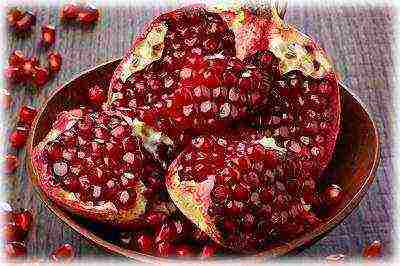 It is believed that the indoor pomegranate tree brings happiness and good luck to the house. That is why the plant is gaining immense popularity among indoor florists.
It is believed that the indoor pomegranate tree brings happiness and good luck to the house. That is why the plant is gaining immense popularity among indoor florists.
The pomegranate grown from the seed is a dwarf plant, reaching a height of about 100-110 cm. It blooms very abundantly and for quite a long time with attractive bright red flowers.
At the same time, such a tree begins to bear fruit no earlier than four years of age. If you want to get fruits in the first year after planting, you need to plant special purchased dwarf pomegranate seeds.
Only a true amateur florist can afford to grow a pomegranate from a seed. Also, tangerines and oranges grow well at home.
Planting seeds (seeds) of pomegranate
A large ripe pomegranate with no signs of rotting or mold is peeled and seeds removed. Those that are white will do. A greenish tint indicates that the seed is unripe and will not sprout.
The pomegranates sold in supermarkets and bazaars are hybrids specially bred to produce high-value products. This means that the fruits grown from their seeds do not retain their parental qualities, including taste.
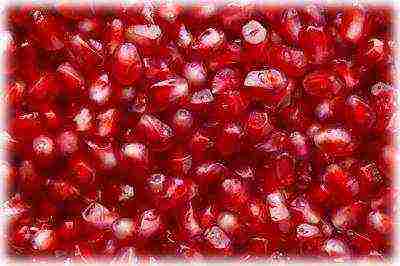 It is believed that freshly harvested seeds germinate better.
It is believed that freshly harvested seeds germinate better.
Seed preparation:
- Free the seeds from the pulp by rinsing in cold water.
- You can wipe them off with a dry paper towel.
- Put on a saucer and dry for 24 hours.
- Soak in water with the addition of epin or zircon for 10 hours.
The soil for planting is prepared loose, including a large amount of coarse river sand. You can combine peat and sand in equal proportions. As a last resort, a ready-made universal soil mixture is used.
Seeds are distributed evenly, buried no more than 1 cm, lightly sprinkled with soil. After planting, be sure to water a little. The pot is located in a warm place in the light and covered with plastic wrap to create conditions close to a greenhouse. The optimum temperature is 25-29 ° C. The mini-greenhouse must be ventilated daily and watered as it dries.
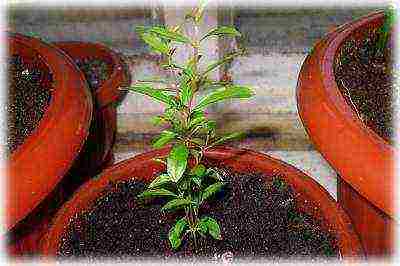 Seed germination of this exotic tree ranges from 85-90%, but they hatch unevenly. The first ones can germinate after 2 weeks. Not finding sprouts after this time, there is no need to rush to throw away, individual seeds "sit" in the ground for up to 6 months.
Seed germination of this exotic tree ranges from 85-90%, but they hatch unevenly. The first ones can germinate after 2 weeks. Not finding sprouts after this time, there is no need to rush to throw away, individual seeds "sit" in the ground for up to 6 months.
If seedlings appeared in the spring-summer period, natural light on a sunny windowsill is enough for them. Additional lighting is needed for seedlings in winter and autumn. Thin and damaged sprouts are removed, leaving a few of the largest ones.
After the formation of a pair of true leaves, pomegranate seedlings dive into pots with a diameter of 8-9 cm. As they grow, they are transferred into large containers.
Caring for a pomegranate at home
When trying to grow a pomegranate at home, it must be borne in mind that this plant is not particularly capricious and grows well in apartments.The main thing is to take into account the basic needs.
Lighting
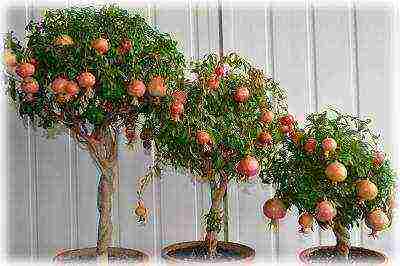 Bright light without direct sunlight is desirable. In the midday heat, the plant needs to be shaded.
Bright light without direct sunlight is desirable. In the midday heat, the plant needs to be shaded.
Temperature regime
The ideal temperature is around 20 ° C in summer and up to 15 ° C in winter. Does not tolerate too low temperatures (less than 5 ° C). It reacts positively to fresh air; in the warm season, pomegranates can be planted in the garden or, in extreme cases, taken to a loggia or balcony.
Priming
It is recommended to use breathable, loose soil. The composition requires coarse sand. It is permissible to use ordinary universal soil for indoor plants. Drainage is laid at the bottom of the pot.
Watering
For irrigation, use settled water at room temperature. The root system is located in the surface layer of the earth, therefore, the soil should not be allowed to dry out. In hot weather it is watered every day and very abundantly. In winter, during the dormant period, watering is sharply reduced.
Air humidity
When growing this crop in stuffy hot rooms, spraying is carried out to avoid pest infestation.
Top dressing
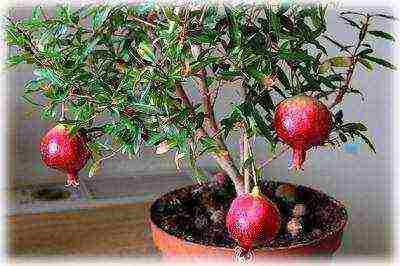 Is it possible to grow pomegranate from the seed without using additional fertilizers? On the one hand, pomegranate, like all indoor plants, responds favorably to top dressing. It is better to give preference to fertilizers in liquid form. From the beginning of March to September, nitrogen and phosphorus should prevail in them: the first is responsible for a lush green crown, the second stimulates flowering. It makes sense to add potassium before the end of October to prepare for wintering.
Is it possible to grow pomegranate from the seed without using additional fertilizers? On the one hand, pomegranate, like all indoor plants, responds favorably to top dressing. It is better to give preference to fertilizers in liquid form. From the beginning of March to September, nitrogen and phosphorus should prevail in them: the first is responsible for a lush green crown, the second stimulates flowering. It makes sense to add potassium before the end of October to prepare for wintering.
On the other hand, if the purpose of growing pomegranates is to obtain fruits and eat them, then it is better to do without any chemistry.
Pruning home pomegranate
To maintain a beautiful appearance, it is not necessary to limit yourself to just removing dried leaves and buds. The pomegranate can and should be trimmed.
Flowers are formed at the ends of strong shoots of the current year, therefore, the main pomegranate shearing is carried out in February.
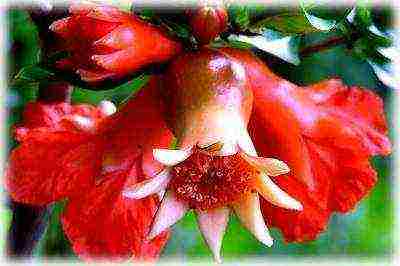 When forming a crown, you need to be guided only by your preferences. Do not be afraid to cut too much, the pomegranate will grow back in the spring. You can show your imagination and make a crown in the form of a bush or form a bonsai - it is perfect for this purpose. Thin and damaged branches are cut out completely, the rest at least by half. After the February haircut, the plant is brought into a warm room, and it is actively growing.
When forming a crown, you need to be guided only by your preferences. Do not be afraid to cut too much, the pomegranate will grow back in the spring. You can show your imagination and make a crown in the form of a bush or form a bonsai - it is perfect for this purpose. Thin and damaged branches are cut out completely, the rest at least by half. After the February haircut, the plant is brought into a warm room, and it is actively growing.
Transfer
Until the age of five, pomegranates require an annual transplant. The pot is selected a little larger than the previous one (by the size of the roots). Further - this is optional. Moreover, the tighter the pot, the more abundant the flowering.
You can periodically replace the top layer of soil with a new one, taking care not to damage the roots.
Possible problems: diseases and pests
How to grow a pomegranate from a stone at home so that it is not affected by pests and diseases? Regular inspection of the plant, periodically carried out preventive measures, timely processing will allow you to grow this exotic tree without any problems.
Major diseases and pests:
Powdery mildew
The most common indoor pomegranate disease. At the initial stage of infection, spraying with a solution of baking soda (5 g per liter of water) helps. In advanced conditions, you cannot do without the use of fungicides (Topaz, Skor).
Learn more about how to deal with powdery mildew!
Spider mite
Appears in hot dry air. The leaves become sticky with white cobwebs. Actellik or Fitoverm are used against ticks. You can try to process it with a folk remedy. 200 grams of tobacco is infused in 2 liters of water for two days, then the plant is sprayed with this tincture.
Read more on how to properly deal with spider mites on indoor plants!
Branch cancer
Weak, damaged specimens are especially susceptible to this disease. The bark cracks heavily on the branches.It is very difficult to get rid of this trouble, the main part of the crown is removed. But even such drastic measures do not always save, often the tree dies.
Aphids and whiteflies
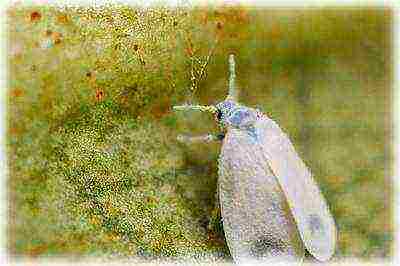 If single malicious individuals are found, the easiest way is to collect them manually. Then treat the leaves on both sides with soapy water.
If single malicious individuals are found, the easiest way is to collect them manually. Then treat the leaves on both sides with soapy water.
Read more on how to get rid of aphids!
With a large number of insects, it is advisable to use chemicals: Aktara, Fitoverm, Actellik, Karbofos.
The answer to the main question: whether a pomegranate grown from a seed will bear fruit primarily depends on the conditions of keeping and caring for it.
This long-lived tree in the wild grows even on rocky slopes and salt marshes. Therefore, if these simple requirements are met, it will delight you with delicious fruits for many years, even at home.
The process of growing pomegranate from seed
The whole issue of the Ukrainian program “All will be good” is devoted to the process of planting and caring for pomegranates. The presenters talk in detail about the main stages:
.
Growing various exotic plants at home is an exciting experience. Indoor gardening fans love to experiment. Seeing the images of a flowering pomegranate bush, there is a desire to plant pomegranate seeds and grow a plant on your own windowsill.
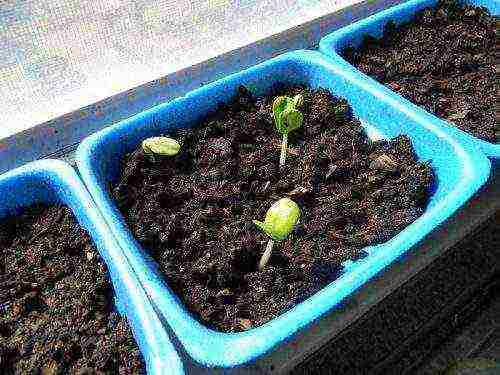
A tree can be grown from a bone
Growing
By following simple instructions and knowing how to properly grow such a plant, you can get a beautiful bush with oval green leaves, beautiful red flowers and edible fruits. Correct agricultural technology will allow you to get a positive result in such an experiment. It is necessary to approach responsibly to all stages in growing pomegranate from a stone.
In order for a pomegranate bush to appear on the windowsill, you need:
- select seeds and prepare them for sowing;
- prepare the soil;
- sow seeds;
- carefully care for the bush.
Seed selection
High-quality seed will be the key to the successful cultivation of a strong and healthy pomegranate bush. If you use seeds from store-bought pomegranates, you need to remember that these are hybrid varieties and a bush that will grow from seeds will not produce fruits with the same qualities as the mother fetus. But this does not prevent to grow a pomegranate from a stone, which will delight you with a lush crown and high decorative qualities.
The seeds for planting are taken from a healthy ripe fruit without damage. Pomegranate pits should be:
- solid;
- ivory;
- no mold or damage.
These characteristics affect germination and future plant health.
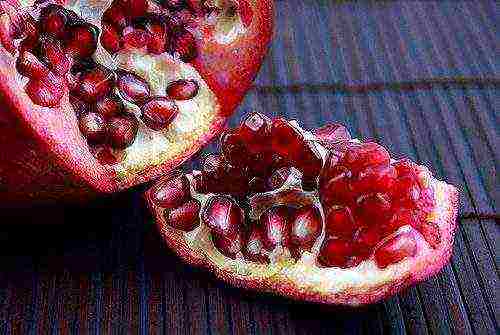
Seeds should be selected from healthy large fruit
Seed preparation
Selected pomegranate seeds must be prepared before sowing in the soil so that they germinate well. To do this, the seeds are washed in clean water so that no pulp remains on them. Clean seeds are dried on a towel for 24 hours.
Already dried seeds for stimulation are advised to be treated with Epin or another phytostimulant; for this, a solution is prepared in accordance with the instructions.
A piece of cotton cloth or gauze is moistened with the solution, and the seeds are wrapped in it. Leave to swell for at least 10 hours. Make sure that the bones do not dry out or become moldy.
Soil preparation
For sowing pomegranate seeds, a universal soil mixture is suitable. River sand can be added to it, in a 3: 1 ratio. Pomegranate is a plant that is not demanding on the soil, which should be:
- moderately nutritious;
- loose;
- with a pH level of 5.5-7.
The soil for sowing pomegranates must be disinfected, as with planting any other plant. This can be done in different ways:
- Spill the soil with a weak solution of magnesium permanganate.
- Fry in the oven at 90 ° C for 30-45 minutes.
- Spill the soil with boiling water.
After such treatment, the chances of infection of young plants with diseases and pests are significantly reduced.
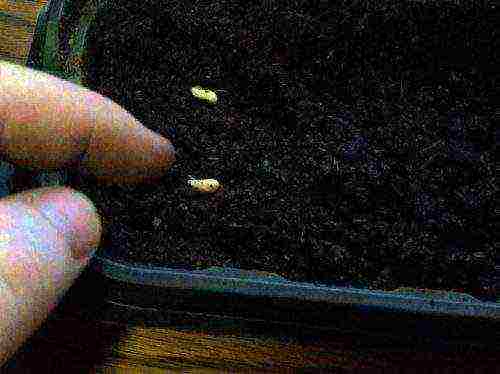
The soil for the pomegranate must be loose
Sowing seeds
For sowing, a container is chosen, it can be a small flower pot, plastic containers, a balcony box. Before using, the containers must be washed well and rinsed with boiling water. The containers are filled with prepared soil, watered with clean water. When the water is absorbed, seeds are sown to a depth of 1-1.5 cm and covered with foil. They are placed in a warm, well-lit place. Seedlings appear on average after 14 days, but it happens that this may take longer.
A few days after the emergence of sprouts, they begin to open the film for a while. After a week, the film is removed completely. Make sure that the soil does not dry out and slightly moisten it. Pomegranate seedlings do not tolerate excess moisture. If a lot of plants have sprung up, then they are thinned out, removing weak and low-quality ones.
Care
Sprouted pomegranate seeds are only half the success, so that young seedlings turn into a pomegranate tree or bush, you will need to carefully care for it.
Transfer
After 2-3 months, the seedlings will grow up, and they need to be planted in separate pots. For the first transplant, you need to pick up flower pots with a volume of 2-2.5 liters. It is not necessary to plant pomegranate seeds directly in large containers, this can slow down their growth. And with a large volume of soil, the plant will use all its strength to develop the root system, and the aboveground part will develop poorly.
Pots 2-3 cm are filled with drainage, for this it is suitable:
- expanded clay;
- small pebbles;
- broken brick;
- shards of ceramic pots.
This will ensure good drainage and prevent excess moisture from accumulating at the bottom of the pot.
The soil for growing pomegranate from the stone is used universal. Fill the pot, make a depression in the middle and moisten slightly. A young plant with an earthen lump is carefully transplanted.
The day after transplanting, pomegranates are watered with Kornevin to stimulate rapid rooting.
The next transplants are carried out as the plant grows in the same way, gradually increasing the volume of the pot. By the age of 5, you need to plant a pomegranate in a tub or pot with a volume of 10-20 liters.
Bush formation
In order for a pomegranate from seeds to grow into a beautiful bush or miniature tree, it must be formed by pinching and pruning branches. The first pinching is done a couple of months after the germination. Pinch the top of the seedling so that it forms side branches. As they grow back, the next pinching is carried out to form the branches of the next order. In this way, you can form a lush crown of a tree or a beautiful branchy bush. Pruning home pomegranates is carried out in the spring before flowering or at any time if there is a need to prune long branches. In an adult bush, you can cut off the branches growing inward, this will improve its shape, and the plant will look neat and well-groomed.
Pomegranate branches easily bend and, by fixing them, you can create a bonsai-style tree with an intricate crown shape. It will look especially impressive during flowering and fruiting.
Conditions and watering
Pomegranate is a thermophilic plant. For him, you need to choose a well-lit place. In the southern regions, the grown pomegranate tree can be planted in open ground. In a cooler area, it is practiced in the summer to keep the plant in the garden or on the balcony.
This crop grows well even in drought conditions, but for full growth and development it requires regular moderate watering. In the hot season, watered twice a week. Water for irrigation should be at room temperature. In winter, when the air temperature drops, the plant begins a dormant period and can last about two months. At this point, watering is reduced and watered no more than once a week.
Fertilizers
For full growth, flowering and fruiting, pomegranate, like other fruit plants, requires regular feeding, especially if it grows in a limited amount of soil at home.
Top dressing is carried out from the beginning of March to November every two weeks. To do this, use:
- mineral complex fertilizers;
- organic feeding.
You can use one type of fertilizer or alternate. For feeding in specialized gardening stores, you can choose the optimal fertilizer for this purpose.
It can be a soluble mineral supplement for citrus or fruit plants. She will be able to fully satisfy the pomegranate's need for nutrients. For adherents of organic farming, humate-based fertilizing is suitable. They are completely sustainable and highly nutritious.
Pomegranate at home can partially or completely throw off the leaves, this indicates the onset of a dormant period. During this period, it is important to remember that there is no need to apply fertilizers. If the seed pomegranate does not have a dormant period in winter, the bushes are fed once a month, reducing the dosage recommended in the instructions by half.
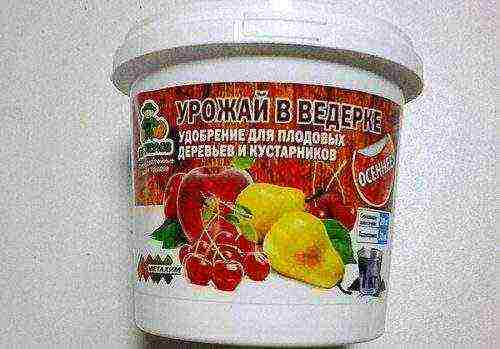
Fertilizer for fruit plants is great for pomegranate
Pests
It is not always possible to protect plants from pests. Grenades can hit:
- aphid;
- spider mite;
- shield;
These pests deplete plants and prevent them from developing fully, so immediate treatment may be required. To get rid of pests, tobacco ardor and garlic infusion are used.
- When aphids or spider mites are found, tobacco dust is sprinkled on the leaves and lightly sprinkled on the soil. You can prepare an infusion, for this 2 tbsp. l. powder is added to 1 liter of water, infused for 24 hours and sprayed on the bush.
- To combat the scabbard, an infusion of garlic peels is prepared. Take 2-3 tbsp. l. the husks are poured with 250 ml of hot water and insisted for at least a day. The prepared infusion is sprayed with pomegranate.
If these funds have not coped with the pests, you can treat the plants with Actellik or Intavir. After treatment with insecticides, the room must be ventilated. The best option would be to spray outdoors.

Intavir - insecticide for pest control
Flowering and fruiting
To grow a pomegranate from a stone, caring for it, everyone is looking forward to the moment of flowering and fruiting. The first flowering is possible in 2-3 years. The pomegranate blooms for a long time, from late spring to mid-summer. The bright red flowers have a bell-shaped shape with protruding stamens, they give the bush a special decorative effect.
With the appearance of the first flowers, the first fruiting can be achieved, for this it is necessary to carry out pollination. Use a cotton swab to transfer pollen from the stamens of one flower to the queen of another.
It is good to pollinate between two bushes, then the percentage of the formed ovary increases. To improve the effect, you can spray with Ovary.
After successful pollination, in a few days the bush will be decorated with small pomegranates, which will ripen in mid-November. Home-grown fruits will not be able to have the same size as in the southern gardens, but their value is great. Small pomegranates will be proof of proper cultivation and care.
Conclusion
Following all the recommendations for growing and caring for pomegranate from the stone, you can get a wonderful result. Such a plant will decorate the windowsill, will delight you with incredibly beautiful flowering and will surprise your friends with the fact that the pomegranate from the seed bears fruit. A positive experience of growing such an unusual plant on a windowsill is a direct path to new experiments in breeding various exotic plants at home.
Subscribe Be aware of new products on our site


